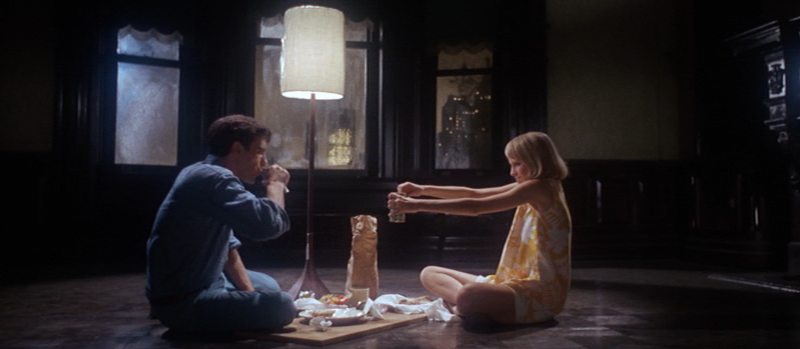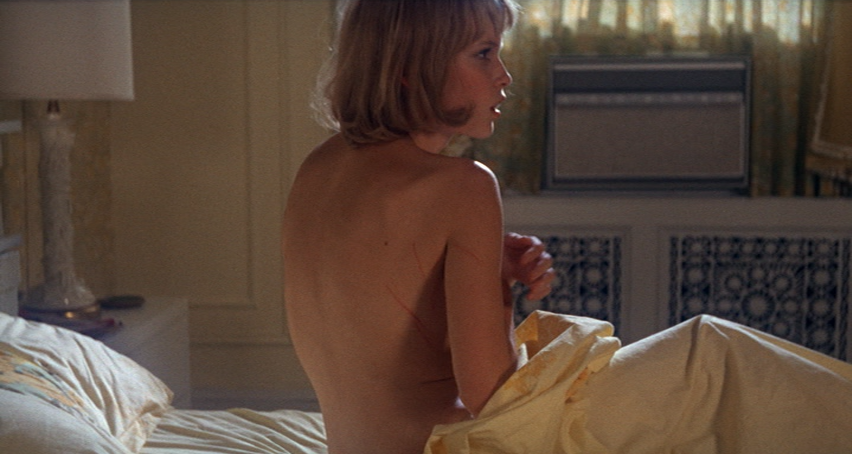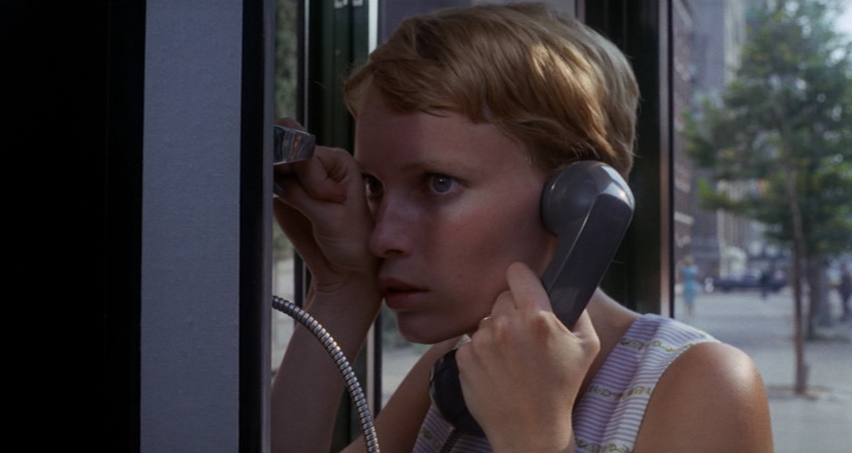

“And it was kinda fun, in a necrophile sort of way.”
Rosemary’s Baby is a classic horror film directed by Roman Polanski, making his American debut, starring Mia Farrow and John Cassavetes. Released in 1968, this film is suffused with religious symbolism, both Christian and satanic, yet manages to keep the narrative cohesive and engaging while playing with a taboo subject. A noticeable departure from the horror films of decades prior, Rosemary’s Baby colors its world with a threatening atmosphere and dark humor, coupled with cinematic elements characteristic of the New Hollywood era.
Throughout the film we never leave the side of Rosemary Woodhouse (Farrow), a young wife who is trying to conceive after moving into a new apartment with her husband, Guy (Cassavetes). Hutch (Maurice Evans), a mentor figure to the Woodhouses, warns them of the unsettling history of their new residence—cannibalism, suicide, demonic summonings, witchcraft, and a dead baby found wrapped in a newspaper. They remain excited about the change, but their positive feelings are mixed with apprehension. Strange occurrences abound in the guise of the coincidental—the previous owner had blocked a closet with a dresser, and had scrawled a mysterious phrase (“I can no longer associate myself”) on a slip of paper prior to her death. Their uneasiness is heightened further when Rosemary’s new acquaintance Terry commits suicide for no apparent reason.
They meet their excessively friendly neighbors, Roman and Minnie Castavetes (Sidney Blackmer and Ruth Gordon) in the street as a crowd gathers around Terry’s dead body, the couple strangely unaffected by the death of their lodger whom they had taken in as their own daughter. Minnie, a nosy and eccentric old woman, invites herself into the Woodhouse’s apartment, explores and comments, and finally invites Rosemary and Guy to dinner. While there, an easy to miss sequence—possibly only telling on repeat viewings—informs us that Roman has planted the devilish seed in Guy’s mind: while Rosemary and Minnie wash dishes, the camera drifts to the living room; we do not see Guy or Roman, only the smoke of their cigarettes drifting across the open doorway. When the young couple reunites, Guy is noticeably off-kilter and begins acting differently toward his wife.

Rosemary always repeats the same line when asked what her husband does; he’s an actor, and he had small roles in ‘Luther’ and ‘Nobody Loves an Albatross.’ Usually extremely focused on his career, Guy surprises Rosemary with flowers, telling her that he has calculated which dates would be most fruitful in their attempts to get pregnant. As the first such night comes around, they sit down to a romantic dinner, but are interrupted when Minnie brings them two chocolate desserts. Though Rosemary does not like the taste and eats only a small amount, she quickly fades and loses consciousness as she tries to walk to the bedroom.
In a harrowing scene, Rosemary’s hallucinatory dreamscape leads her to the lower decks of a pleasure boat, where she suffers through a grotesque ritualistic sexual experience. When she wakes up with scratches on her back, Guy confesses that he had not let her drunken slumber stop him from performing on the scheduled day. And Rosemary does indeed become pregnant shortly after.
Piece by piece, Rosemary puts the puzzle together and becomes convinced that the Castavetes are the hosts of a witch coven. She tries to confide in Guy, but he defends the Castavetes; they have been so kind to the Woodhouses—every day they provide a drink made with herbs to help with her pregnancy, and they refer Rosemary to the best doctor in town, Dr. Saperstein (Ralph Bellamy).
She tries to fight back as she uncovers more elements of the plot against her, but it seems that everywhere she turns she encounters hostile actors who are in on the plot. Or is the entire tapestry one woven in her own mind, a fiction birthed by her own demons? Polanski was intentional about keeping physical evidence of any conspiracy against Rosemary from the viewer. We are deliberately kept from seeing proof of any supernatural manifestations, even so far as to be denied a view of the child.

The film is a brooding one, with a dark humor that evens out the slow-burning intensity that builds until the climax. One thing that sets this film apart is its grounded framework, given its genre. Usually, a mysterious, otherworldly element of evil exists to drive the plot, and the audience’s gradual discovery of this force is essentially what the movie is about. Not so in Rosemary’s Baby; here we are given a large amount of context at the beginning of the film, so that very quickly we have a solid grasp of what the Castavetes are up to. And so the ending is not really a shock; it actually feels inevitable. However, this doesn’t diminish the film at all, because we are not concerned with learning about the supernatural force, we are instead interested in witnessing the malevolent human agents that carry out these evil acts. And maybe that is the most succinct statement the film was trying to make: that the devil does not have to emanate from hell and stalk you specifically, but evil can live behind the face of each person you meet.
Released and set in the late 1960s, there are nods to the decline of morals and religion, and the rise of the satanic in this decade. We see the Pope visiting Yankee stadium, and Rosemary’s Catholic upbringing is mocked; “You don’t need to have respect for him because he pretends he is holy,” says Roman during the first dinner the couples have together. The Church of Satan was founded in the same year in which Rosemary’s baby is born. This era in history also produced such works as the Rolling Stones’ Their Satanic Majesties Request, Donovan’s “Season of the Witch”, and the Beatles’ Sgt. Pepper’s Lonely Hearts Club Band which featured on its cover an image of Aleister Crowley—a notable occultist and founder of the religion Thelema. The theme—if not the actual practice—was pervasive in pop culture. As we see the world through Rosemary’s eyes, we see things from the anti-satanic point of view; we are clearly persuaded to her side while given grounds for doubting her reliability as a narrator. The hammier elements of the ritualistic cult are taken in stride by covering them with moments of humor. For instance, when Rosemary approaches the coven members in the living room, and in a moment of shock drops the large knife she had been carrying, Minnie calmly pulls it free from the floorboard, and gently rubs the floor to survey the damage that had been done to the wood.

The acting is uniformly excellent, and the camera work, wardrobe, and mise en scène are executed perfectly. I revere the subtle long take—the single planned shot that covers a lot of narrative territory without drawing attention to itself. I love these because they take careful planning of the entire scene as well as actors who can, well, act. This film is full of single shots that stretch many times longer than the industry average (especially when compared to the schizophrenic editing of modern Hollywood), and I was actually surprised by how many I hadn’t noticed on my first watch but caught on the second. The most impressive takes place late in the film, as Rosemary frantically tries to make a call from a payphone. She pushes change into the machine, flips through her address book, speaks to someone, and must wait for them to call back. Several times other people approach the booth, and she must improvise a conversation so that they believe she is on the phone. She speaks to herself, talking through her situation, almost laughing at its absurdity. Once she finishes her desperate call, she realizes a man has been standing outside the booth, his back turned; it may be Roman Castavetes, and she composes herself as she turns to meet her fate. Over the span of four minutes and change, Mia Farrow expresses a complex array of emotions while the story covers significant narrative ground. It captures much of what makes cinema uniquely great.